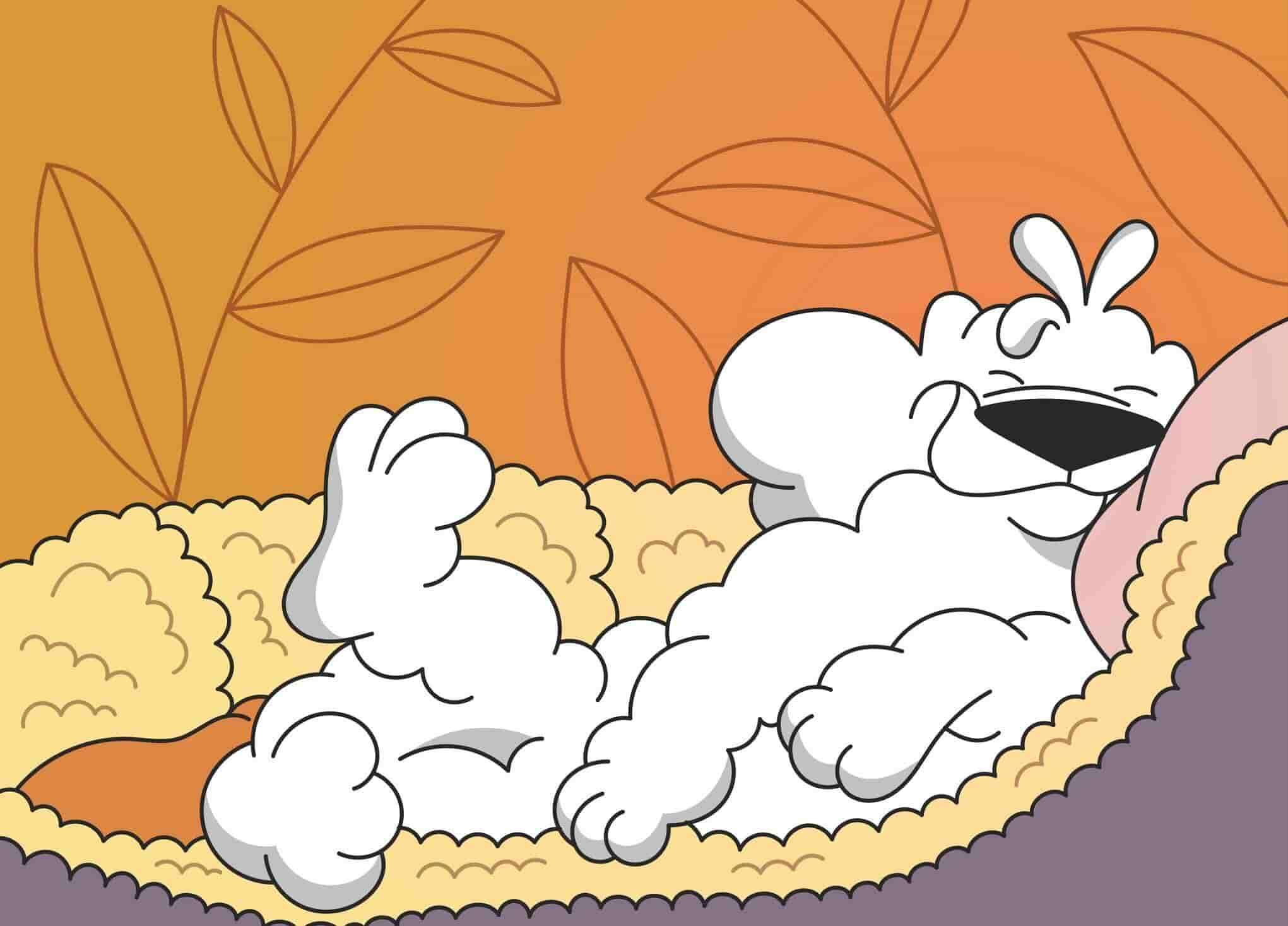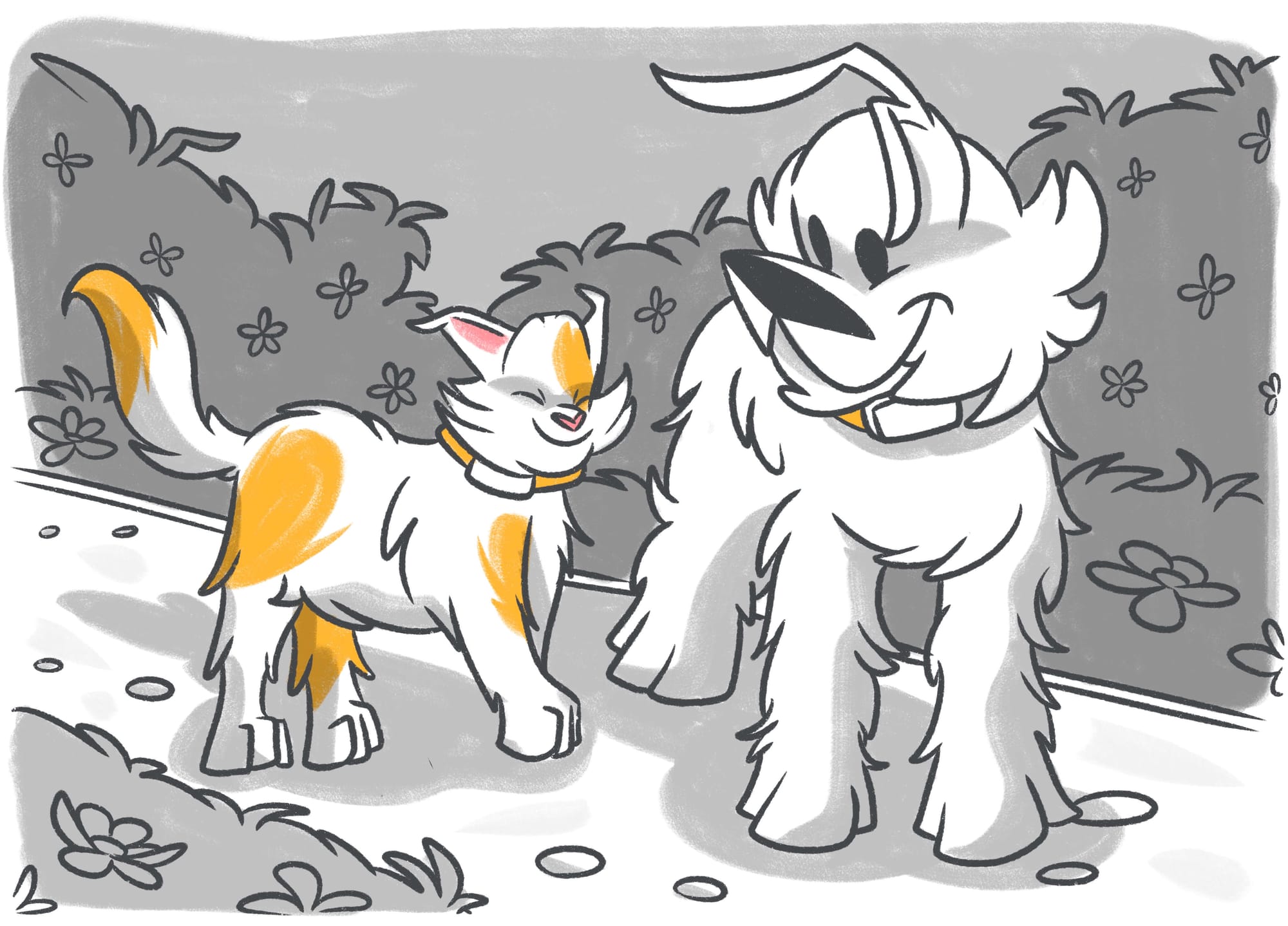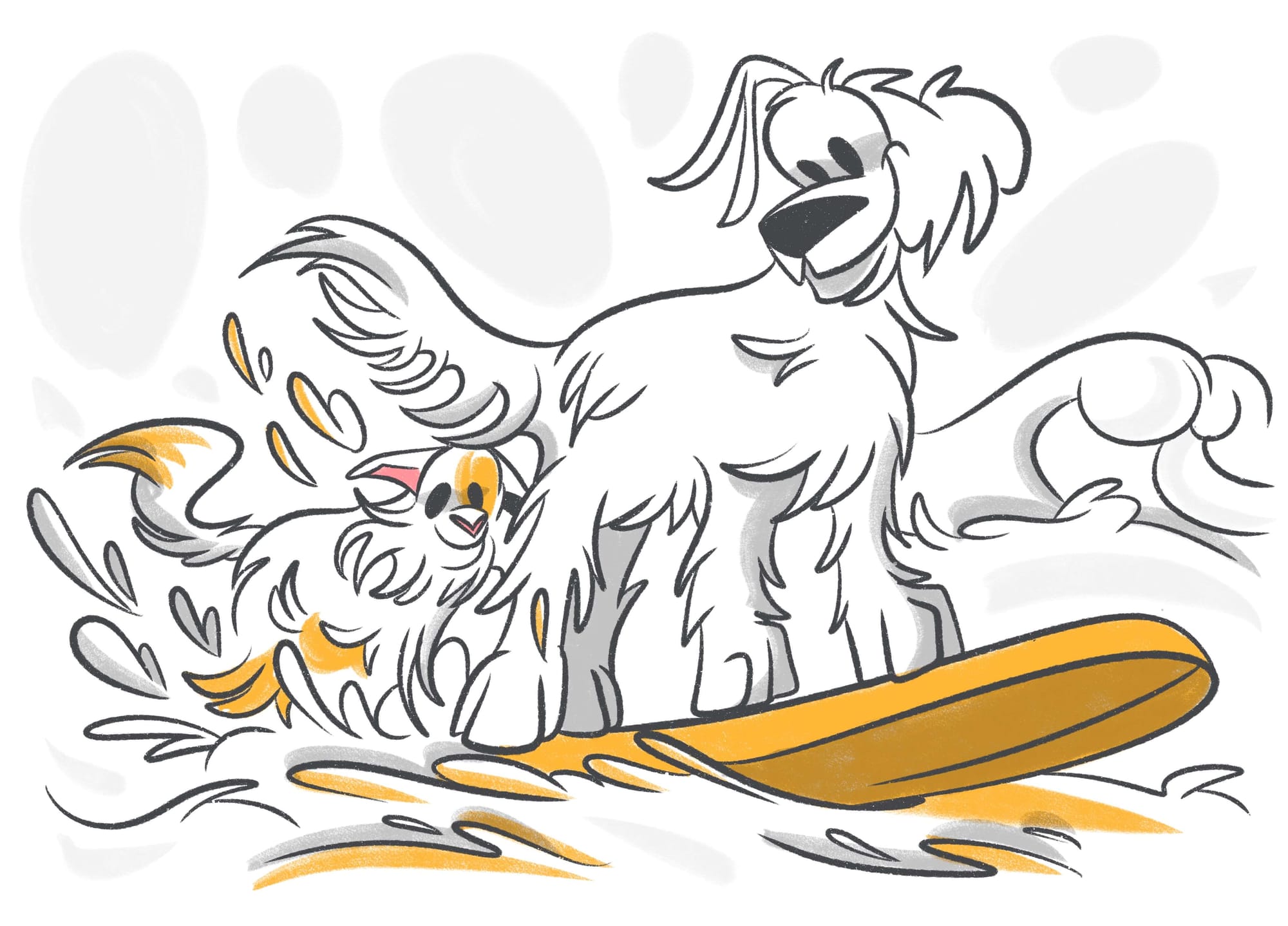Eat, sleep, and play: It’s a dog’s life!
It’s a surprise to many first-time dog owners, just how much dogs sleep. They may even worry their sleeping dog is unwell, because of all those catnaps.
How much sleep do dogs need? Rest assured, it’s quite normal for an adult four-legger to sleep for 12-14 hours spread over a 24-hour period. So yes, it’s normal if your dog sleeps all day. [2]
But wonder how much do puppies sleep and the answer is longer still. For puppies, this is even more at around 18-20 hours. [2]
But why is this? What’s normal and what’s not when it comes to sleeping dogs?
Why Do Dogs Sleep So Much?
While a dog sleeps, he/she is repacking the day’s memories, storing the important ones, and ditching the rest.
Just like people, dogs experience periods of rapid eye movement (REM) sleep. This is when their mind is active, but the body is relaxed.
During the REM cycle, the brain processes daily experiences to make sense of them. And yes, experts believe that dogs do dream.
Sleep also gives the dog’s body a chance to repair itself. Just like people, a dog deprived of sleep has a weakened immune system and is more prone to sickness.
So while a sleeping dog may appear lazy, inside they are very busy indeed.
The Importance of Puppy Naps
Good quality sleep is important for puppy development. That fuzzy fur-ball has a lot of growing to do. Sleep provides a vital downtime for the body to divert energy into growth.
Just like adult dogs, sleep allows the puppy’s brain to make sense of the day. This helps the pup store and remember all that vital obedience training!
Unlike adult dogs, pups have the canine equivalent of an ‘on / off ‘ button with regards to sleep. Their brain is wired to go from full-on play mode, to deeply asleep in the blink of an eye.
Adult Dog Catnaps
Meanwhile, an adult dog has a more gradual wake-sleep cycle. Even when asleep, the dog cycles through periods of wakefulness. They may get up, check everything’s where they left it, then settle back to serious snoozing and re-enter deep sleep. [2]
Did you know a dog’s size influences how long they sleep?
It’s a fact that large dogs sleep more than small ones.
Less of a surprise is that the very young and the elderly, sleep more than regular adult dogs.
Sleeping Behaviors
Have you ever heard a dog barking in their sleep?
Indeed, those muted woofs are a sign of REM or the doggy-dreaming phase of sleep. This occurs in cycles, roughly every 20 minutes.
Other clues to this phase of sleep include:
- A dog whimpering while asleep
- A dog breathing fast while sleeping
- A dog running while asleep
- A dog howling while asleep
- A dog twitching while asleep
Think of this as the difference between ‘quiet’ sleep and ‘active’ sleep, in terms of brain activity.
A sleeping dog spends three-quarters of the time in quiet sleep when nothing much happens. The remaining quarter is active sleep characterized by rapid eye movements (REM), random twitching, and the occasional bark.
During the REM cycle, the brain is as busy and active as when the dog is awake. The difference is that the body is disconnected from the brain, but from time to time, a particular spike of brain activity overrides this sleep paralysis and the dog yips or twitches. [2]
Even more fascinating is that a sleeping dog goes through cycles of semi-wakefulness. This means for every 15 minutes the dog sleeps, they spend an additional 5 minutes awake but groggy. [2]
In an average night, a dog experiences around 23 of these sleep-wake cycles.
Puppies are more active during sleep than adults. This is because the part of the brain which dampens down muscular activity in sleep is less well-developed. Thus twitching, woofing, and running movements tend to escape past the brain’s dampening mechanism.
What do Dogs Dream About
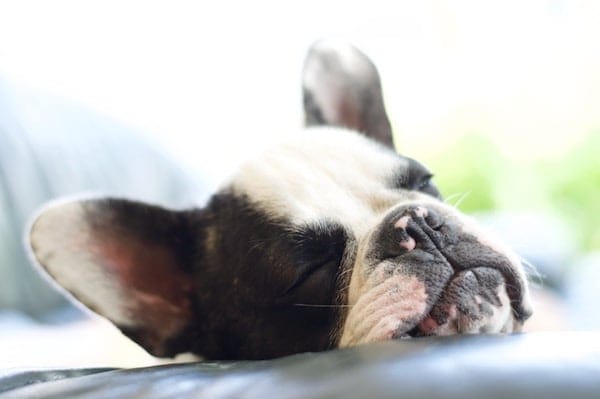
During that REM sleep, what do dogs dream about?
The short answer is that no-one knows for sure because dogs can’t tell us.
However, people experience REM sleep, just like dogs. In humans, we know REM sleep helps repack the day’s events to make sense of them.
It’s reasonable to assume a dreaming dog is thinking about what happened that day, such as playing ball, scavenging a burger, or chasing squirrels.
Can dogs have nightmares?
Again, no one knows. But it does seem reasonable that as dogs dream, they can also have nightmares.
Sleeping Positions
What’s your dog’s favorite sleeping position?
A dog wrestling to keep their eyelids open is a super-sweet sight.
Sleeping means lowering defenses and becoming vulnerable. This influences their sleeping position. Indeed, how they sleep tells you lots about their state of mind.
The Nose to Tail Curl up
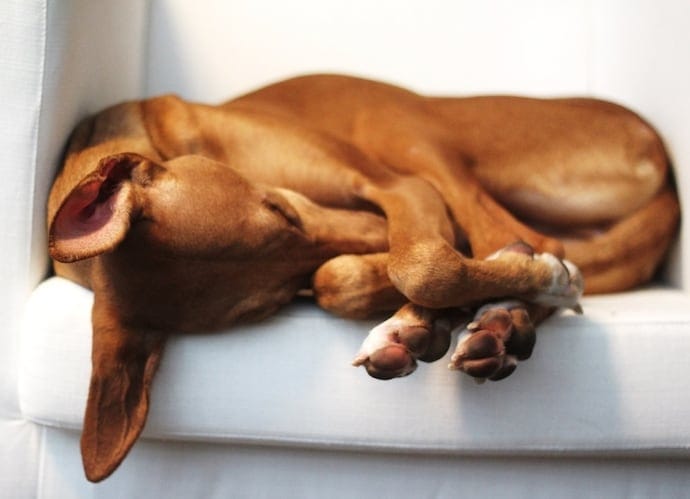
This classic sleeping position conserves heat and protects the vital organs. It’s also super-comfy and means the dog has comforting ‘self-contact’.
The Super-pup Snoozer
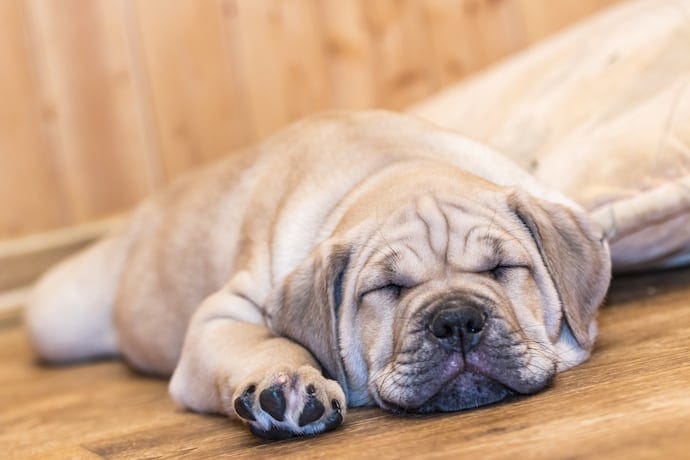
Those dogs that sleep in a superman Ker-splat position are poised and ready for action. Typically these four-leggers can be up and at ‘em at the drop of a hat…or bounce of a ball.
The On-their-Side Sleeper
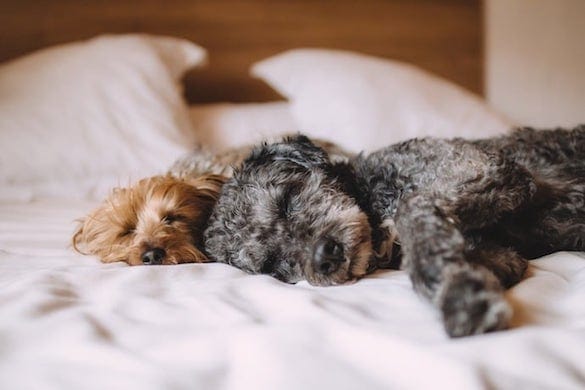
This reflects a dog at ease without a care in the world. Those extended legs leave the belly exposed and potentially vulnerable, but the dog isn’t worried because he knows he’s safe.
The Belly-Up Napper
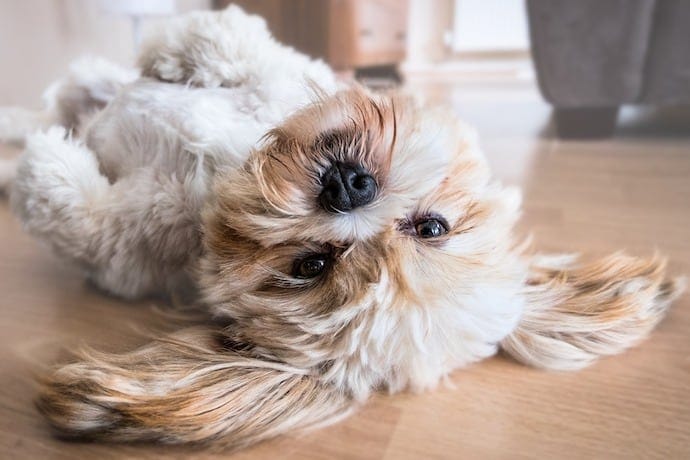
These super-chill dudes could actually be hot. Exposing the thin-furred belly helps the dog lose heat.
Why Do Dogs Like to Sleep between our Legs?
This is all about trust…and comfort.
Close contact with an owner shows a dog is bonded to you. Resting on your legs is an ultimate sign of trust.
This behavior is a hangover from our pet dog’s wild ancestors. In a pack, when danger threatens the dogs crowd together. Safety in numbers. The pressure of their fur-fellows against their sides is reassuring.
Why do dogs like to sleep between our legs?
The same when a four-legger presses into your legs, they are showing their utter trust in your ability to protect when they are asleep and vulnerable. Plus, your legs are warm and the dip is a good fit!
Why Does my Dog Sleep so Close to Me?
Again, this is down to acceptance of you as part of the pack. It’s a deeply-touching sign of trust, so make sure to let pupper know you appreciate it.
Co-Sleeping with Dogs
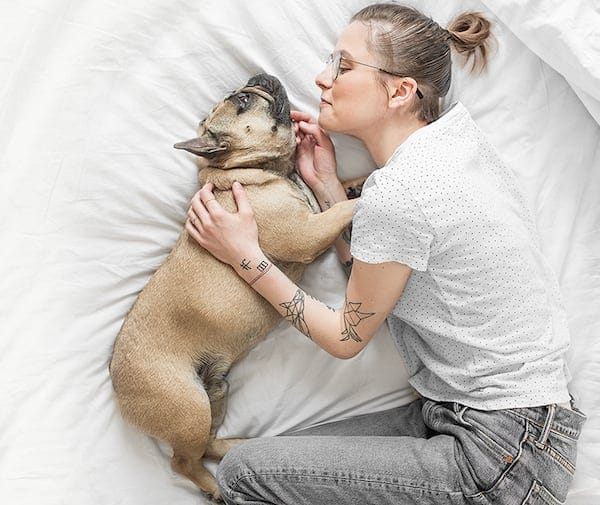
Sleeping with your dog is one of life’s priceless treasures. The soft huff of their breath, the adorable way they snuggle in, and the waggy welcome (and licks) to the new day…all positive reasons for having a dog in bed.
But is a dog sleeping in bed a good idea for the four-legger?
Yes…and there again…no.
It all depends on the dog.
Dogs love comfort…which your bed provides in abundance. To a dog, your bed is a scent extravaganza that smells of their favorite person…you! To be allowed on the bed is a source of great comfort to the fur-friend, but can also be misinterpreted.
Sleeping with dogs risks blurred boundaries. It’s not so much that the dog tries to dominate, but more they can get confused about exactly whose territory the bed is. Thus, a possessive dog may assume this super-comfy sleeping spot is his and his alone and doesn’t want to share with humans.
For this reason, always invite the dog up rather than letting him assume the right. Train him to use the “Up” and “Floor” commands so as to show him what’s expected.
The dog in bed is quite enough, don’t allow him to bring up toys, chews, or biscuits to bed. Again, the latter smacks of it being his preserve rather than yours.
Another possible pitfall of sleeping with dogs is that they become dependent on your presence. When literally by your side 24/7, they can lose the skill of being content when alone. For a dog sleeping in bed, separation anxiety can become an issue.
Separation anxiety is best avoided since it leads to barking, chewing, and other destructive behaviors. To minimize the risk, try to build time into the day when the dog spends time alone, so then it’s no big deal.
If you suspect the dog is distressed when left alone, then Petcube pet camera is your eyes and ears when absent, to get a handle on what’s actually going on.
How Long Can You Leave a Dog Alone?
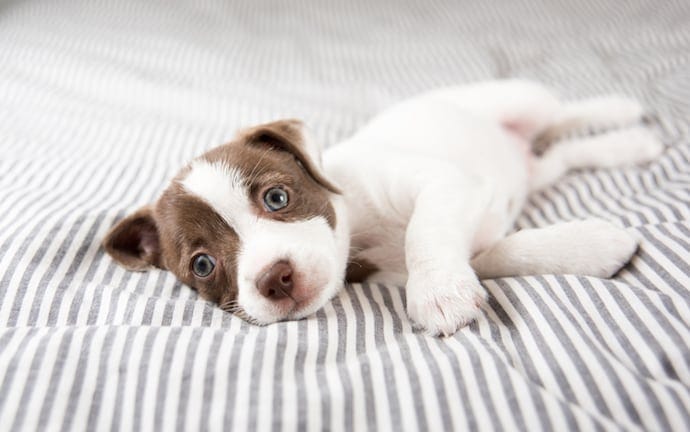
Great question!
It’s generally agreed that 4 – 6 hours is a reasonable amount of time to leave an adult dog alone. But this isn’t based on any hard or fast facts. [1]
The figure of 4 – 6 hours was arrived at by experts after weighing up several factors. These include the dog’s need to stretch, exercise, toilet, and have social contact. But some dogs don’t cope at all when left alone, while others will happily snooze for 10 hours straight given the opportunity.
You can also influence how happy the dog is while you’re gone, and therefore make time spent alone a pleasure rather than a chore.
For example, imagine a dog left in a crate for six hours in contrast to a dog left to roam in a room, with a dog door and free access to a yard.
After six hours, the crated dog is stiff and has an uncomfortably full bladder. Whereas the free dog can get up, stretch, and go outside to relieve themselves. See the difference!
You can also help the time pass by leaving puzzle toys out for the dog. A crowd favorite is a Kong filled with frozen dog food. The four-legger can then spend an hour or two trying to lick out the food before falling asleep.
If you hate leaving your pet alone, then Petcube pet camera can help. The wide angle lens streams your pet’s snooze directly to your smartphone. A great way to breathe easy while at work, knowing your pet pal is peaceful.
Plus you can talk to your dog remotely, and reward them with treats. Use this to reward the dog’s good behavior (such as sitting quietly) so they do more of it. After all, if snoozing equals snacks in Fido’s mind, then what’s not to like?
Puppies – A Special Case
Puppies have a greater need to explore and expend energy than adults, plus their bladders are tiny!
The rule of thumb for puppies is they can hold their bladder for one hour for each month of their age, plus one hour. So a two-month old pup can hold for three hours, a three-month old for four hours and so on.
However, that young puppy has an enquiring mind and bags full of energy to burn. Thus, leaving a pup for no more than a couple of hours at a time is desirable.
Again, Petcube can be a virtual pet sitter. You can see when a puppy starts to get restless and arrange for the dog sitter to call by…either that or take pup-ternity leave to stay with your fur-baby until they are old enough to be left for longer.
Let Sleeping Dogs Lie: When should you Worry?
How much is too much sleep?
Most dogs are creatures of habit. The answer to this lies in knowing what’s normal for your dog and spotting a change.
For example, a dog might sleep for two hours, get up, patrol round to check everything is OK, and then settle back down for another two-hour snooze. This is normal for that dog. If the dog suddenly didn’t stir for 8 hours, then something is wrong.
In an ideal world, all pet parents are aware of their dog’s normal sleep patterns. So when your dog starts sleeping abnormally, you’d be able to see it right away. Petcube gives you 24/7 insight into your pet’s sleeping habits, even when you can’t be with them.
In short, if the dog has changed their habits, especially if this coincides with altered appetite, thirst, or energy, then something’s up. Get your pup checked by a vet.
References
- [1] Rehn, T. and Keeling, L. The effect of time left alone at home on dog welfare. Applied Animal Behavior Science 129 (2011): 129-135.
- [2] Canine Behavior: A Guide for Veterinarians. Bonnie Beaver. Publisher: Saunders. P302-305
Was this article helpful?
Help us make our articles even better

